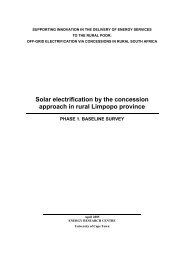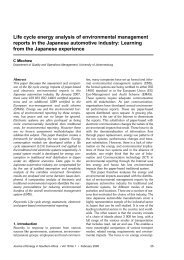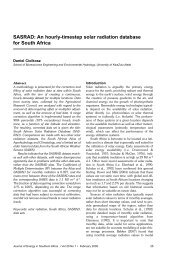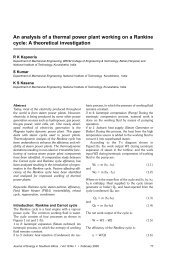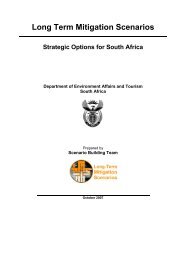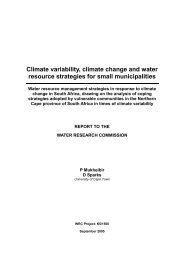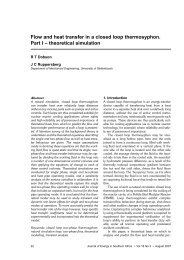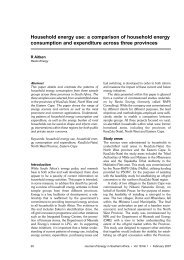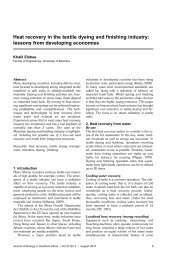(Ed) 2006. Energy policies for sustainable development in South Africa
(Ed) 2006. Energy policies for sustainable development in South Africa
(Ed) 2006. Energy policies for sustainable development in South Africa
You also want an ePaper? Increase the reach of your titles
YUMPU automatically turns print PDFs into web optimized ePapers that Google loves.
26 ENERGY POLICIES FOR SUSTAINABLE DEVELOPMENT IN SOUTH AFRICA<br />
Table 3.1: Global energy and electricity consumption, 2000<br />
Source: IEA (2002a)<br />
Total primary energy supply<br />
/capita<br />
Toe/capita<br />
Electricity consumption<br />
TWh<br />
<strong>South</strong> <strong>Africa</strong> 2.51 194<br />
<strong>Africa</strong> 0.64 399<br />
<strong>South</strong> Korea 4.10 279<br />
Indonesia 0.69 82<br />
Non-OECD 0.96 5 038<br />
OECD 4.78 9 077<br />
World 1.67 14 115<br />
Note: TPES is shown per person, while electricity consumption is the total <strong>for</strong> whole countries or regions<br />
Table 3.2: Global electrification rates <strong>in</strong> 2000<br />
Electrification<br />
rate<br />
Source: IEA (2002b)<br />
Population without<br />
electricity<br />
Population with<br />
electricity<br />
% million million<br />
<strong>South</strong> <strong>Africa</strong> 66.1 14.5 28.3<br />
<strong>Africa</strong> 34.3 522.3 272.7<br />
Indonesia 53.4 98.0 112.4<br />
Develop<strong>in</strong>g countries 64.2 1 634.2 2 930.7<br />
OECD 99.2 8.5 1108.3<br />
World 72.8 1644.5 4 390.4<br />
3.1.3 Demand <strong>for</strong> electricity<br />
Electricity has played, and cont<strong>in</strong>ues to play, a particular role <strong>in</strong> the <strong>South</strong> <strong>Africa</strong>n<br />
economy. It represents a modern energy service to those who have been denied access <strong>in</strong><br />
the past, and it is a major <strong>in</strong>put of <strong>in</strong>dustrial <strong>development</strong>. It makes up 22% of f<strong>in</strong>al energy<br />
demand <strong>in</strong> the country, but this figure understates the role that electricity plays as a high<br />
quality energy carrier. In <strong>in</strong>dustry and manufactur<strong>in</strong>g, the electricity-<strong>in</strong>tensive <strong>in</strong>dustries are<br />
some of the largest contributors to economic growth and exports, and they take up more<br />
than 60% of national electricity sales (Trollip 1996; Berger 2000; DME 2000). Figure 3.4<br />
breaks down f<strong>in</strong>al energy demand by carrier, and shows that liquid fuels and gas make up<br />
the largest s<strong>in</strong>gle share, followed by coal and electricity.<br />
The flow of electricity from production, through distribution, to end use customers is shown<br />
<strong>in</strong> Figure 3.5. (Note: the percentages <strong>for</strong> different sectors <strong>in</strong> Figure 3.5 are <strong>for</strong> electricity<br />
only, while those <strong>in</strong> Figure 3.2 are <strong>for</strong> all <strong>for</strong>ms of energy).




